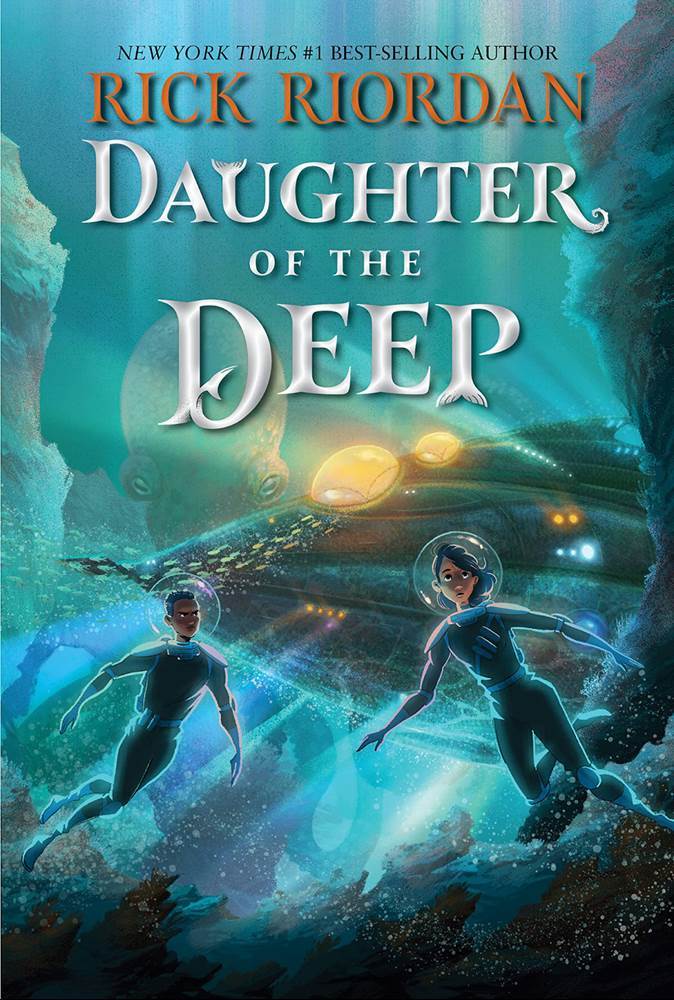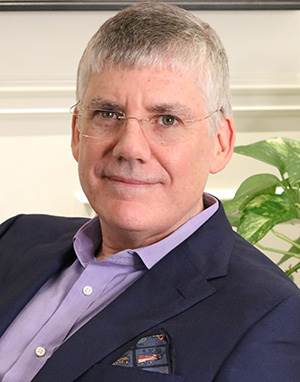Rick Riordan’s latest work Daughter of the Deep will be released on October 26, and I was fortunate to ask the author about writing his latest tale.
Laughing Place: You have talked about your love of Jules Verne and the world of Captain Nemo; as you were writing Daughter of the Deep, was there ever a moment when you questioned your decision to jump into this narrative? What were some of the difficulties in bringing Jules Verne’s classic to life for the middle grade reader?
Rick Riordan: Oh, sure! But that’s true every time I start a book. I always wonder what I’ve gotten myself into, whether I’ll be able to pull it off, and whether I will be able to create a story that kids want to read. Daughter of the Deep had a particularly long gestation period, over ten years, during which time I was letting the ideas stew, trying to find the best way into the story while also doing a lot of research.
Verne is a writer of the 1800s. His style and narrative structure were difficult for me when I was young. I think they are even more difficult for most young readers today. Plus, these novels were not originally written as children’s books. The challenge for me was to preserve the wonder of Jules Verne’s ideas and reframe them in a modern story. Really, that’s not too different than what I do with ancient mythology.
LP: How much of the story did you have mapped out prior to writing, or did the story grow and change as you progressed through your writing process?
RR: I always do a rough outline before I start. With Daughter of the Deep, that outline changed quite a bit over the years. By the time I sat down to write the book, the story had crystallized into its present form, and it didn’t change much during the writing. In that regard, it was unusually cooperative. I suppose I did all the struggling and wrestling with the story during the years when Daughter was on the back burner!
LP: One thing that I have noticed in your work is the level of depth and character you bring to your protagonists. Ana Dakkar has an incredible arc through the book. You place her in unbelievable circumstances while grounding her with real-world issues. How important is it for you as the author to have your readers see themselves in your protagonists?
RR: It’s vital for young readers to be able to relate to the characters. One of the main pleasures of reading, for me, is to imagine what I would do in the protagonist’s place. The characters are our avatars so we can experience their adventures and make them our own. Even when you are in unbelievable situations – and I think we’ve all had some of those over the last few years – humans keep being human. We worry about our families. We worry about our community and the world we are building (or destroying). Ana, for me, is a very relatable character because she is thrust into situations that she does not feel ready to deal with, and yet she must rise to the challenges.
LP: The combat scenes between the Nautilus and Aronnax felt cinematic. Beyond 20,000 Leagues Under the Sea, what films or other stories influenced Daughter of the Deep?
RR: Honestly, Star Trek was a big influence. In my mind at least, there are a lot of similarities between space battles and undersea battles, especially since Star Fleet was modeled on the Navy. Star Trek has always had a strategic and tactical take of warfare that I’ve enjoyed as a viewer.
LP: Are we going to get more adventures with Ana, Gem, and the Nautilus crew from HP?
RR: I wanted to write the book as a stand-alone. I have so many series of books at this point that it can be daunting for readers. Where do I start? Do I have to read all fifteen or twenty books first before I can understand this one? I wanted Daughter of the Deep to be a distinct adventure that anyone can pick up, whether or not they’ve read my other books. Could there be sequels? Sure, the world of Ana Dakkar is vast and interesting. But for right now, Daughter is meant to stand on its own.
LP: Is there another classic work of fiction you would like to take a shot at with a follow up book?
RR: Oh, so many ideas. So little time. I spent years in the classroom trying to find ways to make ancient stories from history and literature connect with my middle school students. It’s one of my favorite things, and one of the reasons Percy Jackson did so well, I think. I would love to pursue other retellings of classic stories. The question is which one will rise to the top of my list of potential projects!
LP: Not only do you have a new book coming out, but your involvement in the Percy Jackson TV show for Disney+ must take up a lot of your time. What has been the most difficult aspect of developing the series so far?
RR: The process has been enlightened and fascinating. I have learned a ton. For instance, Daughter of the Deep was the first book I’ve written where I intentionally structured it like a screenplay, using the three-act structure and a lot of the other tools I’ve been learning to employ from the adaptation process. I suppose the only frustration has been how long everything takes, but that’s hardly a surprise. We’ve been trying to bring this franchise a proper adaptation during a massive corporate restructuring at Disney, during a pandemic, at a time when the entire model for visual entertainment is being upended by the streaming wars. A lot of that chaos has been good for us. It made openings for us to pursue the adaptation in the first place. But it does mean a ton of work and years of constant effort to get things off the ground, often having the same conversations over and over again as the studio executives change. We have made real progress, though, and I’m confident things will start to get into high gear once we get the rest of the required season scripts are delivered, probably around the New Year.
LP: What surprises you the most about the public reception to the Rick Riordan Presents books?
RR: It has been so gratifying to see the support from booksellers, librarians, teachers, reviewers, parents – really everybody. At first, we had to take some time to explain what the imprint was and what it was not. The model was unusual. But once we got up and running, the imprint succeeded beyond my wildest dreams. Part of that, of course, is because we work with such incredible authors who deliver riveting adventure stories for kids. But also, it shows what a hunger there is for new voices and diverse perspectives in children’s fiction. We need these stories. Kids need them. It’s good for all of us, and a lot more interesting, if we have a wide variety of experiences and perspectives represented in the universe of stories. My favorite thing about the imprint is how it has caught on as a model. I hope it has helped encourage the publishing industry to keep diversifying, recognizing that it is not only the responsible thing to do, but also financially wise for their bottom line.
LP: Your writing is beloved my middle graders and their teachers. Speaking from my own experience teaching middle school, a Rick Riordan book is worth its weight in gold. Do you ever feel the pressure of having to deliver another Percy Jackson success?
RR: If you mean do I feel pressure to write another Percy Jackson novel, sure, all the time, but I wanted to do different things. It would have been much easier, and frankly more lucrative, just to crank out Percy Jackson novels for the last fifteen years, but with each series, I needed to keep things interesting for myself, which is why, even when I went back into Percy’s world, I did it in different ways, exploring multiple points of view and introducing new casts of characters. I’m not saying I’ll never write a Percy book again, but I wanted to explore other stories that intrigued me.
If you mean do I feel pressure to do another franchise at the level of Percy Jackson, not really. I recognized as soon as I wrote The Lightning Thief that if I were to have a “break-through” novel, that was going to be it. We should all be lucky enough to have one smash hit series. Expecting to “break through” over and over again with each new book and series would be unreasonable and greedy. Having said that, I’ve been incredibly happy with the reception for all my books. They have done far better than I ever expected, and the arc of my career has been, and continues to be, much longer and stronger than I anticipated. I considered myself incredibly fortunate.
LP: How have you seen the perception of middle grade books change since The Lightning Thief’s publication?
RR: Well, back in my day . . . Oh, sure. There has been a lot of change since 2005. The most positive change has been the sheer range of books available for the middle grades. When I was a classroom teacher back around 2004, it was quite difficult to come up with a good reading list for my kids (i.e. books they actually wanted to read). Harry Potter had wedged open the doors of children’s fiction, and a lot of new writers were getting published thanks to the industry’s sudden realization that kids’ books could be money-makers, but it was still a relatively small field, and the diversity of the offerings was poor. Now, we still have a long way to go, but compared to 2005 there is an embarrassment of riches. That said, “middle grade” still feels a bit like the unloved stepchild of genres. YA is booming. Picture books are perennial favorites. Middle graders need attention, too! That is such a critical, formative time. Statistically, we know that middle school is the time when lifelong readers are created . . . or when kids stop reading. I think we all need to continue having that conversation and making sure those bridge years are properly supported with great reads.
LP: Your social media posts have been highlighting your adventures in scuba diving. From my own experience diving in the Great Lakes, even with repeated dives to the same place, I am always amazed at how I discover something new each dive. What is your favorite place to dive? Why?
RR: Diving is so fascinating. As you say, each time is different, even if it’s at the same spot. I have not explored as many places as I would like, but I have to say that the Silfra fissure in Iceland was magical. The clarity of the water, the vibrant colors, the geology – all just breathtaking. Maybe I should research Hawaii for my next book. I hear there are some great dive sites there . . .
Rick Riordan’s latest work Daughter of the Deep was released on October 26.


